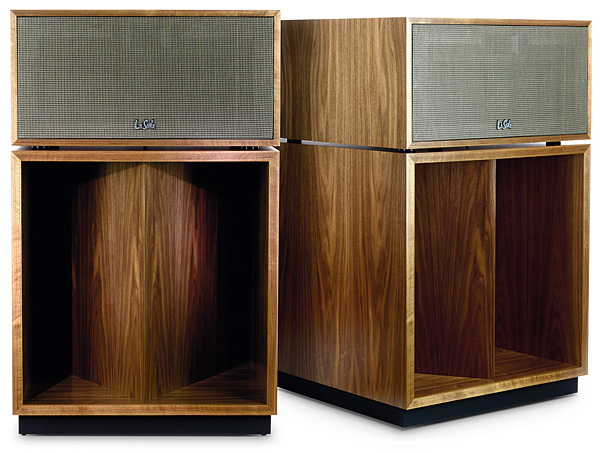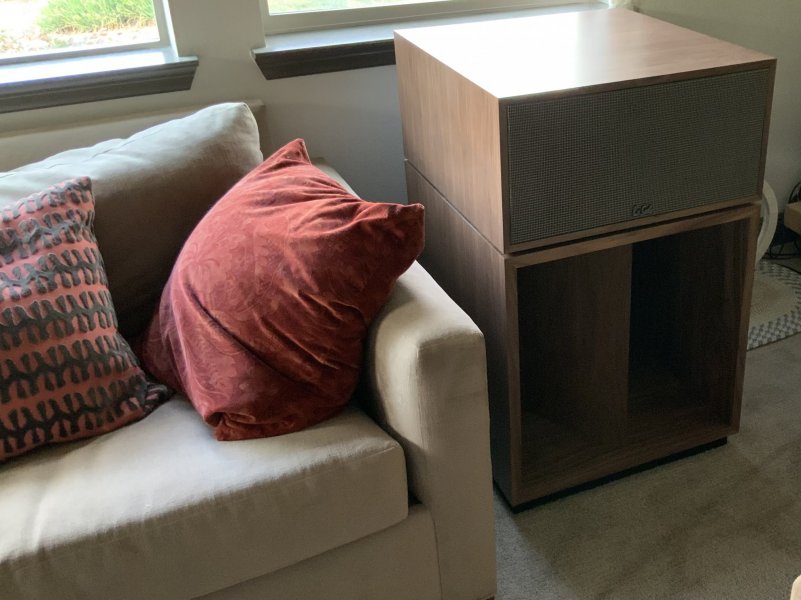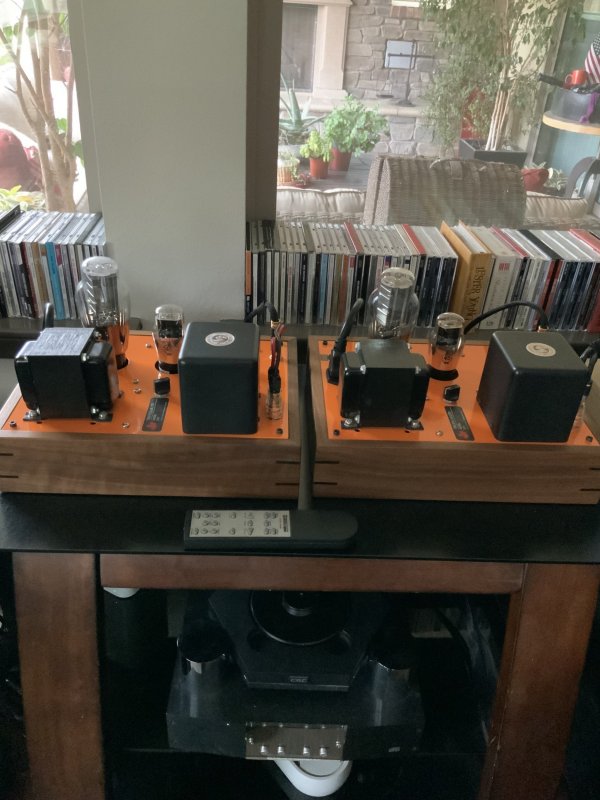Interesting question, as I have the La Scalas and the Harbeth Monitor 40.1s in the same room! One is driven by all tube electronics — ARC 6sE + a SET amp that varies. — and the other is driven by all solid-state electronics (Mola Mola Makula + Kaluga).
The best way to describe the sound of the Harbeth: imagine disconnecting the tweeter/horn of your Klipsch or any other dynamic moving coil loudspeaker! On first listen, you’re immediately thinking: what about the high’s? There is no treble… actually there is, if you measure the Harbeth, you find they are pretty flat up close. The highs are all there, it’s just the treble and midrange resonances that we are so used to are gone. Banished. What’s left is a sound that is almost “dead-sounding”, and that throws off a lot of people. We are so used to listening to loudspeakers that are so colored sounding with a sizzle on top that when you hear the Harbeth, you think something is off. It’s like eating at a fabulous Michelin starred restaurant. I remember a few years ago eating at a fabulous Michelin starred restaurant In southern Italy in Calabria in the quaint little town called Cosenza. I had a tuna dish that felt like it was almost raw, and yet, it was the tastiest tuna dish I had ever had. In food, we are so used to over processed overcooked spicy food that when you eat something that has almost no extra sauces but only pure ingredients, it’s like, whoa! But, you never forget that taste.
But, but, banishing midrange and treble colorations are one thing, getting the rest of the frequency spectrum to sing together is something entirely different. The fly in the ointment of the Harbeth Monitor 40.X sound is the bass, which to my ears sounds very cvercooked. They are expressly designed to sound good when played at a relatively soft volume. The designer Alan Shaw is a big believer in the Flecher Munson curves of human hearing, which shows our hearing acuity drops off exponentially fast in the bass and treble. Our hearing is maximally acute in the 1 KHz range. It is exponentially worse in the region. <100 Hz and above 10 KHz. I suspect most members in the WBF forum — demographics and biology being what it is — can’t hear a damn thing above 12 KHz or so. Are you male? Are you over 60? I suspect that covers a lot of us. Well, I have news for you. You can’t hear a damn thing in the treble. Sorry, that’s life. Males over a certain age have no high freuency hearing left. Woman are far better at hearing high frequencies. Remember that the next time you start thinking about DSD 512 up sampling etc. You might keep the dogs and your bats in the neighborhood happy. It doesn’t help you much cause you can’t hear what’s on a CD anyway!
The other problem with the Harbeth is that they don’t have much in the way of sound staging or reproducing the width and height that audiophiles love. While they do some types of orchestral music well, they cannot begin to match the dynamic range of the La Scalas. Where the La Scalas excel is exactly where the Harbeth’s fall short. They reproduce the sheer dynamic range of a 600 member choral group with stunning dynamics, almost but not quite as well as hearing choral groups live. They have an almost unmatched ability to go loud or soft with no change in their sound. The low distortion in the bass means, next to the Harbeth, they might sound lean. Actually, they have very little deep bass. Now, on to another of my controversial points for many of you. Want to hear deep bass? Go to a concert hall or a church! There is no realistic deep bass in a house of average dimension. Sorry mates, physics being what it is, you cannot reproduce a 20 Hz or even a 30 Hz wave as realistically as you can in a concert hall. Unless you live in a palace, you cannot get deep bass to sound right. What you get is a fake sound like a loud car stereo. Stick to the range above 50 Hz. That you can get right in a listening room. The La Scalas get bass above 50 Hz right, and they go on pretty high, but no extreme treble above 15 kHz. I cannot hear above 15 KHz anyway, so who cares?
In short, if you want an absolutely pure midrange, but flabby bass, and very little sound staging, get the Harbeth. If you want stunning dynamics, accurate bass, exceptional stage width, low distortion, and a very pure sound regardless of volume, get the La Scalas. Keep in mind that for the La Scalas to sound nice, you must, repeat must, drive them with the best SET amp money can buy.. Do not, repeat, do not drive them with a horrible sounding solid state amplifier. You will get grainy treble. The incredibly pure treble horn driver in the La Scala will let you know all the reasons why most solid state amplifiers suck! Treat them nice, get a lovely 45 SET, and you will get a gorgeous sounding speaker.
Life is full of compromises. No speaker will sound like a live orchestra or a live piano or a live saxophone, even if you spent a billion dollars, you are not going to get a loudspeaker to sound like live music, That’s just a basic reality imposed on us from physics and electronics getting in the way. But, we cannot hear Duke Ellington play live nor Ellla Fitzgerald nor hear the Beatles live. So, we live with compromises. The Harbeth and the La Scalas impose different compromises.
Best solution: have multiple loudspeakers and enjoy each one. I use 3 pairs of Quads as well, and I love all my Quads, because for sheer coherence of sound, nothing touches a Quad .But, you cannot play them loud! Life is full of compromises!
Hope this helps.




















